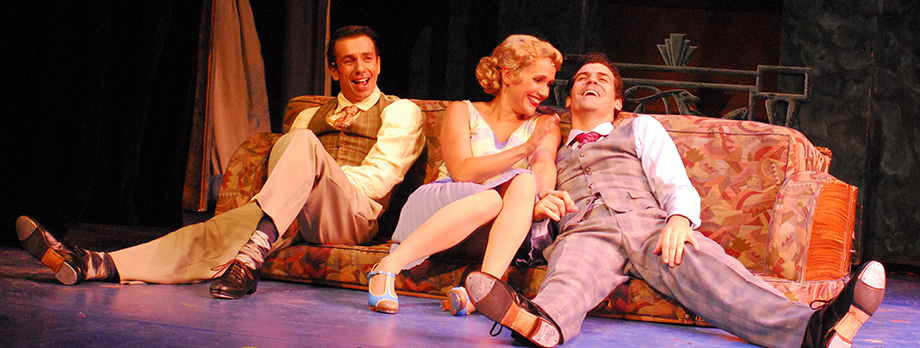ABOUT
Singin’ in the Rain – From Screen to Stage
The stage adaptation of Singin in the Rain is based is set in 1927 and parodies the panic surrounding the troubling transitional period from silent films to “talkies” in Hollywood during the late 1920s as the sound revolution swept the nation. It was a time when many stars found themselves scrambling to improve their diction, singing voice, or in some cases, even learning to speak English in order to maintain their star status and their livelihood! The lead characters in the show, Don Lockwood and Lina Lamont, represent what many film actors struggled with during the late 1920s.
Sound in film was not a new invention in the 1920s; the first sound films had actually been publicly exhibited in Paris in 1900. The difficulty with making “talkies” was the inability to consistently synchronize the sound with the picture, and to do it in an economically practical way. It took decades to perfect. The first commercial screening of movies with fully synchronized sound took place in New York City, in April of 1923. The first feature-length “talkie” was The Jazz Singer, released in October, 1927, which was a box office success earning $2.6 million. Although, much of this movie does not contain live-recorded audio, two scenes with adlibbed speech and two musical performances by Jolson, combined with Jolson’s enormous popularity were enough to impress audiences. The success of this movie jolted the film industry, and its impact on the industry is a major focus of Singin’ in the Rain. By the early 1930s talking pictures were a global phenomenon.
Lyricist and movie producer Arthur Freed, along with his chief collaborator composer Nacio Herb Brown created an extensive library of songs during the 1920s and 1930s, including the song “Singin’ in the Rain,” which was heard for the first time by audiences in the film Hollywood Revue of 1929. Early in his career Freed toured the vaudeville circuit with the Marx Brothers as a writer before signing on with MGM as a lyricist. Freed and Brown originally composed all of the musical arrangements used in Singin’ in the Rain for different Hollywood films. Only two songs were written exclusively for the film, “Fit as a Fiddle” and “Moses Supposes.” After a successful career as a songwriter, Freed went on to produce over 45 hit movies, including Babes in Arms, Girl Crazy (1943), The Harvey Girls (1946), Easter Parade (1948),Annie Get Your Gun, Brigadoon (1954), and Gigi (1958).
Nacio Herb Brown began his career in songwriting in the early 1920s. He signed with MGM in 1928 and under contract produced some of the greatest motion picture scores ever written, including Broadway Melody of 1929, 1936 and 1937, A Night at the Opera, San Francisco and Babes in Arms. However, his greatest success came with the score and title song, “Singin’ in the Rain.” The Brown catalog holds some of the greatest standards from his era, including “All I Do is Dream of You,” “You Are My Lucky Star” and “Make ‘Em Laugh.”
Betty Comden and Adolph Green, the longest running creative partnership in theatre history, were brought on board to write the screenplay for the film by Arthur Freed. Their multiple accomplishments included the books for some of the most iconic musicals ever written for the stage and screen, including: On the Town, Bells Are Ringing, Hallelujah, Baby, Do Re Mi, Peter Pan, Applause, Singin' In The Rain, The Band Wagon, It's Always Fair Weather, and The Barkleys Of Broadway. Comden and Green originally felt they should write the song lyrics as well as the book. However, they soon realized that both Freed and Brown were around during the period at the birth of the talkies. As Comden and Green noted, “it occurred to us that, rather than try to use the songs in a sophisticated contemporary story…they would bloom at their happiest in something that took place in the very period in which they had been written.”
Singin’ in the Rain has had many stage adaptations over the years, including a 1984 English production, a Broadway production, numerous regional theatre productions and most recently a run in London in 2009.

